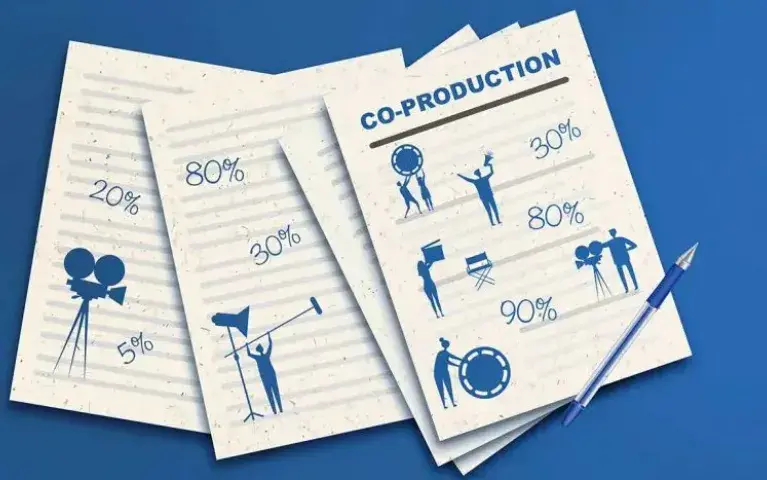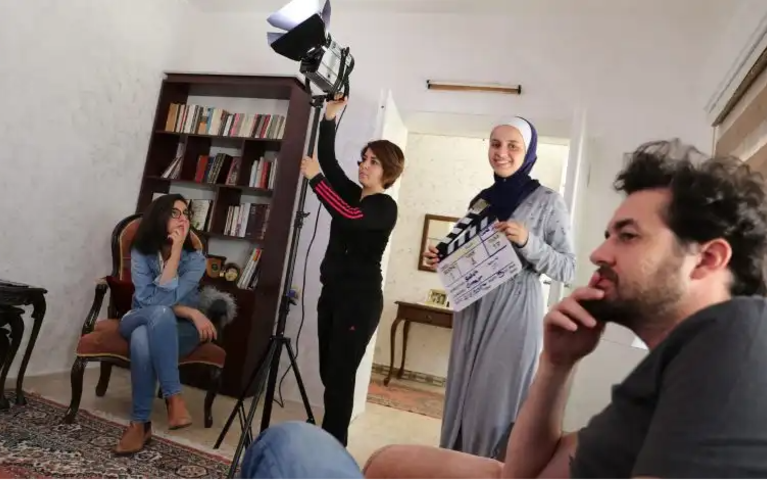Official Co-production Treaty: A Tango Dance, A Marriage and an International Passport

“Co-production: hell on earth but heaven in disguise”. That is how acclaimed producer Roshanak Behesht Nedjad – whom I’ll refer to as Roshi – started her session on co-production back in August of this year’s Amman Industry Days, part of the first edition of Amman International Film Festival. Whether it be hell or heaven, as filmmakers, we are often eager to open that “Pandora’s box”. After all, a co-production is usually perceived as a sign of recognition to one’s work. Roshi, for that matter, made a remarkable analogy that most of us, in the MENA region, can relate to. She placed a film that had secured a co-production in the same position as a person that had secured an international passport. It can easily travel.
When drafting a forward to a publication by the European Audiovisual Observatory on The Legal Framework for International Co-production, Maja Capello, Head of the Department of Legal Information, placed co-production in a more romantic position. She used a quotation by Argentinian writer Jorge Luis Borges; “Tango is a direct expression of something that poets have often tried to state in words: the belief that a fight may be a celebration.” She then went on to highlight the similarities between co-producing and tango-dancing in the sense that “the results might be worth a celebration, but obtaining these results will certainly require a fighting spirit. And a flair for handling cultural diversity too.”
What is an Official Co-production?
There is more to the word than what it simply implies. While the literal meaning of it indicates that the work has been realized with the involvement of more than one party, there are certain requirements that need to be fulfilled for a film to achieve the status of an official co-production.
An official co-production adheres to the treaties issued by the European Convention on Cinematographic Co-Production. A bilateral, or a multilateral co-production agreement, under the European Convention, usually binds the involved producers, who are established in different parties of the convention, together. The work will be a national one in each of the countries where the producers operate. Public funding will, therefore, be eligible in all of those countries represented by a producer.
The possibility of the involvement of countries, which aren’t part of the Convention, is adequate given that their total contribution does not exceed 30% of the production’s budget. In that case, a non-member country is referred to as a third country. It is important to mention here that being a signatory country is not limited to EU countries. Countries like Argentina and Canada have become members of the Convention.
Certainly, the word co-production may encompass productions that are implemented with the involvement of two non-signatory countries and those that would take place among companies from the same country. Those forms, however, are not considered official and, therefore, do not grant the film the “national status” that the official co-production treaty offers.
How to Grant Your Film the International Passport?
The analogy made by Roshi is very relevant here. Becoming a citizen in a country involves certain requirements, let alone being a citizen in more than one. While co-producing with the European convention grants the film a national treatment in the respective country involved, it also has a demand on the financial and cultural structure. This includes percentages of shares by each country involved.
- Financial and Economic Structure
Below is an illustration of contributions required from parties (countries) involved under the Convention on Cinematographic Co-Production.
| Minimum Contribution | Maximum Contribution | |
| Non-Party (Third Country) | 10% | 30% |
| Bilateral Party | 10% (previously 20%) | 90% (previously 80%) |
| Multilateral Party | 5% (previously 10%) | 80% (previously 70%) |
“By definition, according to the treaties, if I produce a film where 60% of the money comes from Germany, 35% comes from Norway and 5% comes from Jordan, this is a German- Norwegian film.” This applies even if the film is shot in Jordan, if the language is Arabic and if the dialect is Jordanian. The film will receive two EU citizenships along with all the benefits of those respective nationalities. While it may be disappointing to see the film lose its initial identity, Roshi offers a consoling clarification: “This is an economic definition. It’s not an artistic definition.” She goes on to confirm, “It is an economic, political definition! I am now doing a film which is German, and in-part Polish language. We shot 12 days in Germany, 21 days in Luxemburg and 8 days in Poland. The majority was in Luxemburg. The language is German and Polish. Nothing Luxemburgish except that we shot and got money from there. This is officially a co-production that has three nationalities. This is not necessarily why the film gets a citizenship. I can do a German Italian film in Farsi!”
- Cultural Structure
For a production to qualify as European and access the benefits of the European Convention on Cinematographic Co-Productions, it must achieve at least 15 out of possible 19 points.
| European Elements | # of Points |
| Creative Group | |
| Director | 3 |
| Scriptwriter | 3 |
| Composer | 3 |
| Cast | |
| First role | 3 |
| Second role | 2 |
| Third role | 1 |
| Crew | |
| Cameraman | 1 |
| Sound recordist | 1 |
| Editor | 1 |
| Art director | 1 |
| Studio or shooting location | 1 |
| Post-production location | 1 |
If the work has been written and directed by a Jordanian citizen who lives in a signatory country, then the production has achieved six cultural points. If the main role is played by an actress who resides in one of the signatory countries, the film eventually loses its Jordanian nationality and becomes identified by that of the signatory countries involved in its production.
Why Commit to a Marriage and Tangle in the Tango?
In her description of what a co-production is, Roshi made yet another metaphor that makes the involvement in a co-production more comprehensible. “In Iranian it’s called a Sieghe,” she said. “You practically are marrying your partner(s) for a certain amount of time. If you cannot stand them, if you don’t like them, it’s going to be the war of the roses at some point.” Maja Capello, on the other hand, reinforced Roshi’s statement using her initial tango metaphor. “In the same way that it takes two to tango, it also takes two to tangle! Like any other type of relationship, tying the co-production knot can very quickly lead to an “entangled” situation if one chooses to overlook certain factors.” She also utilized the marriage metaphor to describe the consequences in case that marriage went wrong, “For example, such a marriage can be marred by a badly drafted co-production contract, leading to an ugly divorce.”
“What can go wrong?” one may wonder. Below is a list of challenges to consider:
• Expensive: Co-production will definitely increase the cost of a cinematic work. Salaries of creative and technical crew are more expensive in signatory countries. The cost is appended by fringes and social security which causes the budget to sky-rocket. With a more diverse team, the line of a travel cost as a budget item will definitely be impacted as cast and crew will need to be flown in from different countries.
• Complicated Legal Systems: Structures and legal systems are different in each of the involved countries. This will eventually impact the contracts and allow them to become more complex.
• Cultural Differences: As much as cultural diversity can be a blessing to a cinematic work, as much as it can raise differences. One needs to be aware of the cultural misunderstandings that may rise for them to be prepared to deal with it.
• Weakening Content: “It’s a bit of a tightrope,” Roshi opened her palms out and held them in a vertical position, one on top of the other, “At one point, making the script and the project in a way that people beyond your borders can understand and cherish your project is good,” she said. “But not to an extent where you would give up your content and the core element of the content.” Having other parties from other backgrounds involved may cause them to raise their own concerns about a production and try to come up with their own input. A filmmaker should be careful not to dilute content. If a filmmaker ends up trying to make his/her film good for everyone, he/she may lose his/her own original reasoning behind what he/she is doing.
On the other hand, and despite the issues, the fears and the high-stakes, there is a myriad of reasons why one would want to pursue a co-production:
• Financial: Most of the time, pooling financial resources comes on top of the list. The national status that a co-production gives makes it eligible for the film to receive public funding in each of the countries involved. Signatory countries involved provide national treatment and access to subsidies that will facilitate both the completion and the distribution of the film.
• Creative Input: Artistic collaboration and cultural exchange between artists from diverse experiences and backgrounds is always a strength that leads to a richer outcome.
• Technical Needs: Some countries have technical facilities that are not available in other countries. A good example that Roshi brought up entailed the possible need to film underwater. In Germany, where she lives, that will be so difficult. To achieve that scene, she needs to go to Belgium where a water tank is available.
• Access to Foreign Markets: The involvement of producers, each from a different country, will help the film reach a wider audience. They will have better knowledge of what the people want to see in their territory. Therefore, it will be easier to obtain pre-sales or local investment, which will help the distribution of the work in each country.
• Sharing Risk: It is easier for a filmmaker to get people to say “yes” when they have other people share their risk and invest in their project.
It is essential that filmmakers are aware of all the risks highlighted above. One of the primary precautions to take and determine the success of their work, is to draft a thorough contract that protects them against any loopholes and threats that may come up.
Our Status as Non-member States
Regardless of the number of convention-member countries involved in a co-production, and because countries from the MENA region are non-members, they are usually referred to as a third country. Hence, the share of the non-signatory, non-member, MENA country in a cinematic work cannot exceed 30%. It would, nonetheless, be challenging for a filmmaker from that region to bring the majority of financing to an official co-production. There is always the possibility of applying for a derogation that may allow for the opportunity. A recommendation that is often valuable to try and follow, is to consider producing the film without the hassle of a treaty co-production. Although competitive and extremely difficult to access, there are many film funds and grants, local and international, that a film can receive and that can help it make its way to the big screen. After all, it may make life easier to quit the dance, not to commit to that marriage and content yourself, and your film for that matter, with a single nationality.
* Areeb Zuaiter is a visual storyteller and a professor at the School of Communication at the American University and Howard University. She teaches Visual Literacy, Media Production and History of Documentary.















